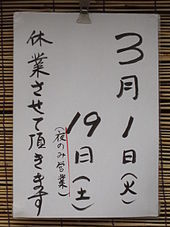- Manual keigo
-
Manual keigo (マニュアル敬語), is a controversial form of honorifics (keigo) in the Japanese language. Employers such as fast-food and convenience-store chains publish training manuals for employees, especially young part-timers who have little experience with honorifics. These manuals incorporate nonstandard formulas for servers and cashiers to use when addressing customers, most often by using alternate expression which are longer and vaguer than the standard expression. Manual keigo is opposed by language purists on the grounds that keigo has fixed, unchangeable grammatical constructions.
Other terms for the same phenomenon include "part-timer's (baito) keigo," "convenience-store keigo," and "family-restaurant keigo."
Contents
Forms
X no hō wa/ga
The use of X no hō wa originally refers to direction. In a contrasting sentence it is used to express preference to one thing instead of another. (Example: X yori Y no hō ga suki da. ("More than X, [I] like Y.") In baito keigo, X no hō wa/ga is used to refer to the way to a seat (which is technically correct usage because it refers to the seat's direction) and also to refer to customer's preference between several options. (Example: gamushiroppu no hō ga ikaga desu ka? ("as for gum syrup, how about [it]?") The latter usage is disputed because instead of X no hō wa/ga, the particle wa in X wa has the standard meaning of "as for X."
N ni narimasu
The use of N ni narimasu (N is a noun phrase) to mean desu is manual keigo. For example, in a restaurant, a server brings the customer's food and says ebi doria ni narimasu. Here, the meaning is simply ebi doria desu ("[this] is shrimp doria"). The construction ni narimasu as a substitute for desu is grammatically incorrect Japanese, appearing to the hearer similar to the English phrasing "This'll be the shrimp doria". In modern Japanese narimasu is a polite construction for the verb naru, meaning "to become," but nothing in X ni narimasu is transforming or becoming something else. The standard keigo expression is "ebi doria de gozaimasu." While the phrase "X ni natte imasu" (and its humble equivalent, "X to natte orimasu") does carry the meaning of "X desu", it implies a state of being rather than a physical object, as in, "Tōten wa zenmen kin'en to natte orimasu" ("This restaurant is completely smoke-free").
O-azukari shimasu
Cashiers frequently accept a sum of money from a customer and acknowledge receipt by saying, for example, ichi man en o-azukari shimasu – this phrasing is pervasive. The verb azukaru, literally "[I] temporarily take into custody", implies that the recipient will return the thing he or she received – it is used when accepting checked luggage, for instance – but cashiers do not return the total to customers. The proper form is x en wo chōdai shimasu. The proper form is "ichi man en o chōdai shimasu," as chōdai shimasu is the standard, humble expression for accepting money. ichi man en o itadakimasu ("[I] humbly accept 10,000 yen") is also used.
X kara
In addition to the proscribed use of o-azukari shimasu, cashiers may also use kara ("from"), as in ichi man en kara oazukari shimasu. This causes the sentence to mean "[I] temporarily take into custody from 10,000 yen." Due to the unstated and implied subject, it is possible to misunderstand the sentence as the 10,000 yen itself takes custody of something.
Irasshaimase konnichi wa
The double greeting is a form of manual keigo, as is the evening pattern irasshaimase konban wa. It sounds like "welcomegoodafternoon" or "welcomegoodevening." Irasshaimase by itself is the proper greeting.
Otsugi no okyaku-sama
"[The] honorable next honorable customer" is also nonstandard keigo. Purists maintain non-polite words can not be indiscriminately made polite by merely adding o or go (both prefixes meaning "honorable.") Although okyaku-sama (literally "Mr. Honorable Customer") is an accepted form of address of respect to a customer, adding o to tsugi ("next") is baito keigo.
A similar proscribed usage is "[name of food ordered] + no okyaku-sama" (example: ebi doria no okyaku-sama ("shrimp doria customer")), which is disputed because the customer is not literally shrimp doria.
Sasete itadakimasu
This form is created by conjugating verbs with the saseru ("to force/to allow/let") + itadaku ("to accept/to receive the favor of.") It is called sasete itadakimasu because suru ("to do") is often attached to nouns which can function as verbs with suru. For example, a store will place a sign outside stating honjitsu (wa) kyūgyō sasete itadakimasu. (Today, we receive the favor of you allowing our store to be closed.) The frequency to which sasete itadakimasu (we receive the favor of you allowing us to...) is disputed, as baito keigo users tend to indiscriminately use it refer both to what they will do and what they want the customer to do, creating a who's on first?-style confusion about who is going to do what. Additionally, sasete itadakimasu is quickly replacing traditional forms like shite itadaite and shite kudasatte.
See Also
Sources
- This article includes material from the article バイト敬語 (Baito Keigo) in the Japanese Wikipedia, retrieved October 20, 2007.
- keigo sisin houkokuan (pdf), Bunka Shingikai Kokugo Bunka-kai, November 8, 2006 (retrieved October 20, 2007)
Further reading
- "Sono baito keigo wa yamenasai" (Satoko Kobayashi, ed.) Nikkei Publishing 2004[1]
- "The Use of "Baitokeigo" on Part-time Jobs by Young People : State of Mind of Speakers and Impression of Listeners" (Shin Horasawa and Eriko Oka) Bulletin of the Faculty of Regional Studies, Gifu University vol. 19 pp. 1–31[2]
Categories:
Wikimedia Foundation. 2010.

